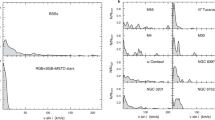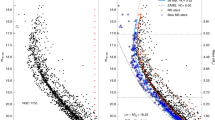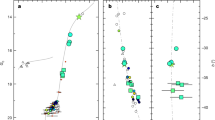Abstract
Stars in globular clusters are generally believed to have all formed at the same time, early in the Galaxy’s history1. ‘Blue stragglers’ are stars massive enough2 that they should have evolved into white dwarfs long ago. Two possible mechanisms have been proposed for their formation: mass transfer between binary companions3 and stellar mergers resulting from direct collisions between two stars4. Recently the binary explanation was claimed to be dominant5. Here we report that there are two distinct parallel sequences of blue stragglers in M 30. This globular cluster is thought to have undergone ‘core collapse’, during which both the collision rate and the mass transfer activity in binary systems would have been enhanced6. We suggest that the two observed sequences are a consequence of cluster core collapse, with the bluer population arising from direct stellar collisions and the redder one arising from the evolution of close binaries that are probably still experiencing an active phase of mass transfer.
This is a preview of subscription content, access via your institution
Access options
Subscribe to this journal
Receive 51 print issues and online access
$199.00 per year
only $3.90 per issue
Buy this article
- Purchase on Springer Link
- Instant access to full article PDF
Prices may be subject to local taxes which are calculated during checkout




Similar content being viewed by others
References
Marín-Franch, A. et al. The ACS Survey of Galactic Globular Clusters. VII. Relative ages. Astrophys. J. 694, 1498–1516 (2009)
Shara, M. M., Saffer, R. A. & Livio, M. The first direct measurement of the mass of a blue straggler in the core of a globular cluster: BSS19 in 47 Tucanae. Astrophys. J. 489, L59–L63 (1997)
McCrea, W. H. Extended main-sequence of some stellar clusters. Mon. Not. R. Astron. Soc. 128, 147–155 (1964)
Hills, J. G. & Day, C. A. Stellar collisions in globular clusters. Astrophys. J. 17, 87–93 (1976)
Knigge, C., Leigh, N. & Sills, A. A binary origin for ‘blue stragglers’ in globular clusters. Nature 457, 288–290 (2009)
Meylan, G. & Heggie, D. C. Internal dynamics of globular clusters. Annu. Rev. Astron. Astrophys. 8, 1–143 (1997)
Ferraro, F. R. & Lanzoni, B. in Dynamical Evolution of Dense Stellar Systems (eds Vesperini, E., Giersz, M. & Sills, A.) 281–290 (Proc. IAU Symp. 246, Cambridge Univ. Press, 2008)
Mapelli, M. et al. The radial distribution of blue straggler stars and the nature of their progenitors. Mon. Not. R. Astron. Soc. 373, 361–368 (2006)
Trager, S. C., Djorgovski, S. & King, I. R. in Structure and Dynamics of Globular Clusters (eds Djorgovski, S. G. & Meylan, G.) 347–355 (Astron. Soc. Pacif. Conf. Ser. 50, Astronomical Society of the Pacific, 1993)
Bailyn, C. D. Are there two kinds of blue stragglers in globular clusters? Astrophys. J. 392, 519–521 (1992)
Leonard, P. J. T. Stellar collisions in globular clusters and the blue straggler problem. Astron. J. 98, 217–226 (1989)
Ferraro, F. R., Sills, A., Rood, R. T., Paltrinieri, B. & Buonanno, R. Blue straggler stars: a direct comparison of star counts and population ratios in six Galactic globular clusters. Astrophys. J. 588, 464–477 (2003)
Sills, A., Karakas, A. I. & Lattanzio, J. Blue stragglers after the main sequence. Astrophys. J. 692, 1411–1420 (2009)
Davies, M. B., Piotto, G. & de Angeli, F. Blue straggler production in globular clusters. Mon. Not. R. Astron. Soc. 349, 129–134 (2004)
Cariulo, P., Degl’Innocenti, S. & Castellani, V. Calibrated stellar models for metal-poor populations. Astron. Astrophys. 421, 1121–1130 (2004)
Ferraro, F. R. et al. The giant, horizontal, and asymptotic branches of Galactic globular clusters. I. The catalog, photometric observables, and features. Astron. J. 118, 1738–1758 (1999)
Tian, B., Deng, L., Han, Z. & Zhang, X. B. The blue stragglers formed via mass transfer in old open clusters. Astron. Astrophys. 455, 247–254 (2006)
McMillian, S., Hut, P. & Makino, J. Star cluster evolution with primordial binaries. I – A comparative study. Astrophys. J. 362, 522–537 (1990)
Hurley, J. et al. Deep Advanced Camera for Surveys imaging in the globular cluster NGC 6397: Dynamical models. Astron. J. 135, 2129–2140 (2008)
Ferraro, F. R. et al. Discovery of carbon/oxygen-depleted blue straggler stars in 47 Tucanae: the chemical signature of a mass transfer formation process. Astrophys. J. 647, L53–L56 (2006)
Stetson, P. B. DAOPHOT – A computer program for crowded-field stellar photometry. Publ. Astron. Soc. Pacif. 99, 191–222 (1987)
Stetson, P. B. The centre of the core-cusp globular cluster M15: CFHT and HST observations, ALLFRAME reductions. Publ. Astron. Soc. Pacif. 106, 250–280 (1994)
Pietrukowicz, P. & Kaluzny, J. Variable stars in the archival HST data of globular clusters M13, M30 and NGC 6712. Acta Astron. 54, 19–31 (2004)
Vilhu, O. Detached to contact scenario for the origin of W UMa stars. Astron. Astrophys. 109, 17–22 (1982)
Hartigan, P. Computation of the dip statistic to test for unimodality. Appl. Stat. 34, 320–325 (1985)
King, I. R. The structure of star clusters. III. Some simple dynamical models. Astron. J. 71, 64–75 (1966)
Harris, W. E. A catalog of parameters for globular clusters in the Milky Way. Astron. J. 112, 1487–1488 (1996)
Noyola, E. & Gebhart, K. Surface brightness profiles for a sample of LMC, SMC, and Fornax galaxy globular clusters. Astron. J. 132, 447–466 (2006)
Djorgovski, S. in Structure and Dynamics of Globular Clusters (eds Djorgovski, S. G. & Meylan, G.) 373–382 (Astron. Soc. Pacif. Conf. Ser. 50, Astronomical Society of the Pacific, 1993)
Acknowledgements
This research was supported by Progetti di Ricerca di Interesse Nazionale 2008, granted by the Istituto Nazionale di Astrofisica. We acknowledge the financial support of the Agenzia Spaziale Italiana and the Ministero dell’Istruzione, dell’Università e della Ricerca. F.R.F., B.L., E.D. and A.S. thank the Formation and Evolution of Globular Clusters programme and the Kavli Institute for Theoretical Physics in Santa Barbara (California, USA) for hospitality during their stay, when the motivations of this project were discussed and the work planned. We acknowledge support from the European Space Research and Technology Centre Faculty Visiting Scientist Programme. R.T.R. is partly supported by a Space Telescope Science Institute grant. This research has made use of the ESO/ST-ECF Science Archive facility, which is a joint collaboration of the European Southern Observatory (ESO) and the Space Telescope European Coordinating Facility (ST-ECF).
Author Contributions F.R.F. designed and coordinated the study. G.B., E.D. and S.B. analysed the data. A.S. and A.I.K. developed collisional models. B.L. and P.M. computed the surface density profile and performed comparisons with a single-mass King model. F.R.F. and B.L. wrote the paper. F.F.P., A.S. and R.T.R. critically contributed to discussions on, and the presentation of, the paper. All the authors contributed to discussions of the results and commented on the manuscript.
Author information
Authors and Affiliations
Corresponding author
Supplementary information
Supplementary Information
This file contains Supplementary Notes, Supplementary Table 1 and Supplementary References. (PDF 128 kb)
Rights and permissions
About this article
Cite this article
Ferraro, F., Beccari, G., Dalessandro, E. et al. Two distinct sequences of blue straggler stars in the globular cluster M 30. Nature 462, 1028–1031 (2009). https://doi.org/10.1038/nature08607
Received:
Accepted:
Issue Date:
DOI: https://doi.org/10.1038/nature08607
This article is cited by
-
Fast rotating blue stragglers prefer loose clusters
Nature Communications (2023)
-
A new class of fossil fragments from the hierarchical assembly of the Galactic bulge
Nature Astronomy (2020)
-
The “dynamical clock”: dating the internal dynamical evolution of star clusters with Blue Straggler Stars
Rendiconti Lincei. Scienze Fisiche e Naturali (2020)
-
Size diversity of old Large Magellanic Cloud clusters as determined by internal dynamical evolution
Nature Astronomy (2019)
-
A MODEST review
Computational Astrophysics and Cosmology (2018)
Comments
By submitting a comment you agree to abide by our Terms and Community Guidelines. If you find something abusive or that does not comply with our terms or guidelines please flag it as inappropriate.



